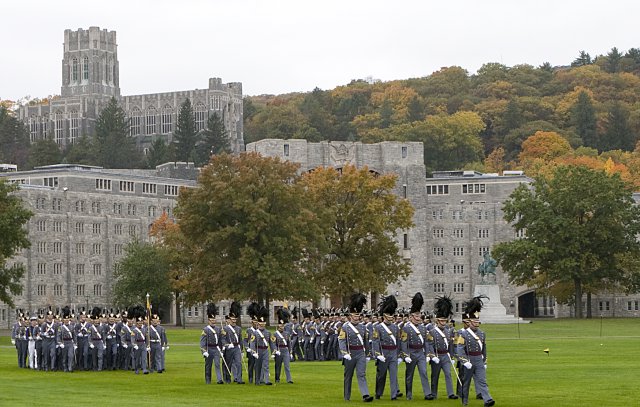 by Dave Best – Galin Education College Counselor
by Dave Best – Galin Education College Counselor
If you are dreaming of becoming a commissioned officer of the United States Armed Forces, you should consider one of the five service academies. With training programs for the Army, Navy, Air Force, Marines and Coast Guard, these institutions combine a college degree with leadership development followed by a career in the Armed Forces.
Admissions to these programs is highly competitive and often requires nominations by a US Senator, US Representative, Vice President or high-level military officials. In fact, less than 8% of applicants to the US Naval Academy received offers of appointment. Successful applicants typically blend top academics, leadership and physical fitness.
At West Point, the Air Force Academy and Coast Guard Academy, students are cadets, while at the Naval Academy and Kings Point, students are midshipmen. These programs all feature tuition-free education along with room and board included. Cadets and midshipmen commit to a specified number of years of service to pay back their education.
Listed below is a snapshot of each of the five service academies’ mission statements with links to their websites and class profiles:
The United States Military Academy has been educating, training, and inspiring leaders of character for our United States Army and for the nation for more than 200 years. West Point provides a 47-month leader-development program steeped in academic rigor, military discipline, and physical challenges, all built upon a moral-ethical foundation. The academy is an internationally recognized institution for academic, military and physical excellence, and we are proud that today’s cadets will become tomorrow’s military, public and private-sector leaders.
West Point’s purpose is to produce leaders of character who are prepared to provide selfless service to our Army and the nation. West Point provides a broad-based and balanced curriculum to ensure graduates acquire knowledge, skills, and attributes necessary for them to effectively address the complex and uncertain challenges they will face in their personal and professional lives. When students enter the United States Military Academy at West Point, they are beginning a profession. Career development starts on the first day; everything cadets experience is focused on developing them as leaders of character who will serve as officers in America’s Army upon graduation, when they are commissioned as second lieutenants in the U.S. Army. As they begin their military careers, they become leaders of Soldiers, and each new promotion brings additional responsibility and increased opportunity.
The Academic Program
West Point strives to admit the best and brightest each year to ensure that the classrooms are places of intellectual rigor and stimulation, places where knowledge passes not just from instructor to cadet, but from cadet to cadet as well. West Point’s Academic Program serves as a foundation for the development of critical thinking and creative problem-solving skills. It includes a substantive set of fully integrated core courses that, together, provide an appropriate balance between technical topics and the humanities. Cadets choose their areas of depth from more than 40 academic majors that span a broad spectrum of academic disciplines. The academic curriculum culminates with an integrative experience that is often an interdisciplinary and team-based project. Through the Senior Capstone experience, students draw upon and apply knowledge in their chosen majors as well as knowledge gained throughout the course of their studies. Often these projects provide real answers to real-world problems, result in presentations at academic conferences, and bring national recognition. Upon graduation, all cadets receive a Bachelor of Science degree and are fully prepared to meet the intellectual requirements of a leader in today’s army.
The Physical Program
The Physical Program at West Point includes both physical education classes and competitive athletics. It contributes to mental and physical fitness and allows the cadet to achieve the highest levels of physical development through a program that emphasizes a lifelong pursuit of personal fitness. The physical education curriculum spans all four years, and physical education class grades are incorporated into the cadet grade point average, highlighting the importance of physical fitness in the Army. Every cadet must participate in competitive sports throughout the academic year, whether in varsity intercollegiate athletics, intercollegiate clubs, or company athletics. The program challenges cadets every day but is widely regarded as both rewarding and enjoyable.
The Military Program
While academic courses are the building blocks of most typical universities, career development at West Point is geared toward the cadet’s goal of being an officer in the United States Army, so military discipline and training are paramount to their officer development. Cadets are immersed from day one in a military environment where they are organized in companies and serve in leadership positions within the Corps of Cadets. The heart of the military training takes place during the summer. The basic Soldier skills of rifle marksmanship, land navigation, and close combat are but the underpinnings of each cadet’s initial training the first summer; by graduation every cadet has participated in small-unit leadership training; attended military schools such as Airborne and Air Assault; served as senior leadership to junior cadets’ summer training; and interned as an office in active duty units across the globe. Each summer of training builds the leadership skills of the previous, so that by graduation each cadet is prepared to lead Soldiers and serve our nation. No matter what major course of study they choose, cadets graduate with the knowledge, confidence, and ability to be successful in their careers.
Tuition and Financial Aid
Tuition is free as is room and board. A first-year cadet earns more than $900 a month, and the amount increases each year. A portion of that cadet pay is deposited into a personal checking account. Another portion of cadet pay is deposited to a “Cadet Account” that is used to help a cadet pay for expenses such as uniforms, books, a computer, activity fees, etc. Each cadet pays a standard amount for laundry, dry cleaning, haircuts, tailoring services and shoe repair. A cadet’s gross salary is subject to federal and state withholding taxes and Social Security deductions.
Location
The USMA is located in West Point, New York in Orange County. It sits on scenic high ground overlooking the Hudson River, 50 miles north of New York City.
As the undergraduate college of our country’s naval service, the Naval Academy prepares young men and women to become professional officers of competence, character, and compassion in the U.S. Navy and Marine Corps. Naval Academy students are midshipmen on active duty in the U.S. Navy.
They attend the academy for four years, graduating with bachelor of science degrees and commissions as ensigns in the Navy or second lieutenants in the Marine Corps. Naval Academy graduates serve at least five years in the Navy or Marine Corps.
About the Academic Program
To prepare midshipmen as Naval officers, the Naval Academy’s curriculum blends professional subjects with required and elective courses similar to those offered at leading civilian colleges. Our curriculum has three basic elements:
Core requirements in engineering, natural sciences, the humanities and social sciences, to assure that graduates are able to think critically, solve increasingly technical problems in a dynamic, global environment, and express conclusions clearly.
Core academic courses and practical training to teach the leadership and professional skills required of Navy and Marine Corps officers.
An academic major that permits a midshipman to explore a discipline in some depth and prepare for graduate level work.
Tuition and Financial Aid
There is no tuition or financial aid at the Naval Academy. The Navy pays 100% of the tuition, room and board, medical and dental care costs of Naval Academy midshipmen. This means ALL students who attend the Naval Academy do so on a full scholarship in return for 5 years of active duty service upon graduation. Additionally, you also enjoy regular active-duty benefits including access to military commissaries and exchanges, commercial transportation and lodging discounts and the ability to fly space-available in military aircraft around the world. Midshipmen pay is $1027.20 monthly, from which laundry, barber, cobbler, activities fees, yearbook and other service charges are deducted. Actual cash pay is $100 per month your first year, which increases each year thereafter.
Location
USNA is located in Annapolis, the capital of Maryland which is considered the “Sailing Capital of the World.” Located 33 miles east of Washington, DC and 30 miles southeast of Baltimore.
US Air Force Academy (Air Force)
In both war and peacetime, the United States Air Force is a critical component of a strong, innovative nation. Choosing the Academy is an act of patriotism — in troubled times more than ever. If you are called to serve, the United States Air Force Academy can position you to play a critical leadership role.
It is not a matter of affording the tuition or finding a scholarship or grant. An Academy education is valued at more than $416,000, yet we offer it at no cost to our cadets. All that is required in return is your commitment to serve as an officer in the Air Force. The length of commitment depends on your career path and other opportunities, such as graduate or medical school, that may extend it.
While others spend their college years unsure of their career outcomes and at great cost to their families, you will be on a fast track to something more. We’ll develop your skills, your character and your motivation. Your future with the Air Force will allow for focused ambition, purposeful self-discovery and impactful study during your college years.
Our investment in developing well-rounded leaders at the Academy pays untold dividends to our nation. You get a free, top-notch education, free room and board, free medical and dental benefits and the opportunity for an exciting career as an officer in the Air Force. Our country gets leaders with drive, smarts, character and motivation. Everyone wins.
ACADEMICS
An Academy education is tailored to develop future Air Force officers with innovative, analytical and resourceful minds. A fully accredited institution of higher learning, the Academy has one of the most prestigious and respected academic programs in the nation. Each cadet completes a balanced sequence of core curriculum with courses in sciences, engineering, humanities, social sciences, military studies and physical education. Cadets may choose an academic path from 27 majors with an option to add a foreign language, philosophy, or religion studies minor. The chance to succeed academically is offered to every cadet. With a student to faculty ratio of 8:1, cadets have unprecedented access to professors. Beyond the classroom, cadets may participate in real-world research, study abroad and create connections through a variety of professional clubs.
MILITARY
The Academy provides the training and foundational leadership experiences that prepare cadets to become officers in the United States Air Force. Every cadet starts their Academy experience with Basic Cadet Training (BCT). Upon completion of BCT, cadets join the cadet wing, which simulates the structure and organization of an operational Air Force wing. As cadets take on increasing levels of responsibility over the course of their four years at the Academy, their leadership capabilities are explored and enhanced. Military education is where Cadets learn to become officers by taking subjects such as military strategy, doctrine, heritage, professionalism and more. Every cadet who enters the Academy is presented with numerous opportunities to take part in the flying experience. Some are voluntary, others are mandatory.
ATHLETICS
In addition to managing a full academic load, cadets must maintain a high level of physical conditioning and participate in athletic competition. The Academy’s extensive athletic program includes intercollegiate and intramural sports, physical education courses and physical fitness tests. These programs help prepare cadets for Air Force leadership by building confidence, emotional control, physical courage, and the ability to perform under pressure. The Academy has 10 women’s and 17 men’s National Collegiate Athletic Association (NCAA) teams that compete at the highest level, Division I. Each cadet must participate in an intercollegiate or intramural sport, selecting from an extensive array of options including basketball, boxing, soccer, softball, tennis and volleyball.
CHARACTER
Above all else, the Academy creates leaders who will serve our nation in the United States Air Force. To do so, we emphasize character as the basis upon which great leadership depends. Our core values are Integrity First, Service Before Self, and Excellence in All We Do. While at the Academy, cadets internalize these values through character-based transformational leadership education. The 4-year curriculum begins with personal exploration followed by interpersonal skill development. Cadets continue by building servant leadership skills and finally, pursuing organizational improvement through analysis of ethical dilemmas. Classroom, seminar, workshop and experiential learning programs — including an Adventure-based learning (ABL) ropes course — propel cadets along their character development journey.
Tuition and Financial Aid
An Academy education is valued at more than $416,000, yet we offer it at no cost to our cadets. All that is required in return is your commitment to serve as an officer in the Air Force. The length of commitment depends on your career path and other opportunities, such as graduate or medical school, that may extend it.
Location
The United States Air Force Academy is located 55 miles south of Denver and eight miles north of Colorado Springs.
United States Merchant Marine Academy is a federal service academy that educates and graduates licensed Merchant Marine officers of exemplary character who serve America’s marine transportation and defense needs in peace and war. With 95 percent of the world’s products transported over water, these leaders are vital to the effective operation of our merchant fleet for both commercial and military transport during war and peace. Academy graduates abide by the motto “Acta Non Verba” – deeds not words, and are leaders that exemplify the concept of service above self.
Known for its rigorous academic program, USMMA requires more credit hours for a baccalaureate degree than any other Federal service academy. This challenging coursework is augmented by the Academy’s Sea year experience, which affords midshipmen the opportunity to acquire hands-on, real-world experiences aboard working commercial vessels sailing to ports around the world. Midshipmen who master this demanding curriculum earn a unique combination of credentials:
– An highly-regarded Bachelor of Science degree
– A U.S. Coast Guard license
– An officer’s commission in the U.S. Armed Forces
About the Program
The Academy is located in Kings Point, New York. Its 82-acre waterside campus lies on Long Island’s north shore, about 20 miles east of New York City. The Academy is a national institution, operated by the Federal Government’s Maritime Administration, an agency of the U.S. Department of Transportation.
The Academy’s Regiment of Midshipmen numbers approximately 950 young men and women who represent every state of the Union as well as U.S. Trust Territories and Possessions. The size of the student body contributes to a true sense of camaraderie among the members of the Regiment and permits the Academy to maintain an excellent student-teacher ratio.
A sound college education is the foundation for every profession in our society and the mariner’s profession is no exception. The academic curriculum at the Academy is accredited by the Middle States Commission on Higher Education and provides each midshipman with the broad college education required for a bachelor of science degree, with the specialized training for licensing as a merchant marine officer, and with the military knowledge for commissioning in a reserve component of the Armed Forces. Few colleges can offer such a full range of credentials at graduation.
Challenging Environment
The Academy challenges its midshipmen intellectually and physically. The academic program is demanding, the regimental system rigorous. Freshman (fourth class or plebe) year is particularly strenuous as students make the transition from high school graduate to Academy midshipman. In their first few months, they learn many new terms, the quality of endurance, how to perform under pressure, and most importantly, how to successfully manage time.
During sophomore (third class) year, and again during junior (second class) year, midshipmen are sent to sea for practical shipboard training. Aboard ship, sailing the trade routes of the world, they learn the value of self-reliance and initiative as they gain firsthand experience in the mariner’s environment.
In senior (first class) year, they fine tune the skills learned in the classroom and at sea as they prepare to enter the Professional world.
Making the Sacrifice
Enrollment at the Academy requires many personal sacrifices, but the goal is worthwhile. Students must be prepared for numerous demands on their time, a degree of stress, and some limitations on their personal freedom. In return, the Academy develops leaders and prepares its graduates for careers that are bounded only by their talents and desire.
Tuition and Financial Aid
Midshipmen attending the United States Merchant Marine Academy (USMMA) receive from the Federal Government their full tuition, room and board, uniforms, and books at no cost!
Midshipmen are, however, responsible for the payment of certain costs of educational supplies and services, which are NOT provided by the government. These include:
– Academy approved personal laptop computer
– Activity fees (intramural athletic, cultural events, health services, student newspaper, yearbook, etc.),
– Licensing Fees (TWIC Card, MMC Document, and USCG Licensing Exam Fees)
– Personal fees (self-service laundry, barber shop, and tailoring charges).
– Personal expenses & transportation costs for liberty and leave periods
USMMA participates in the Federal Student Aid (FSA) program. All students, regardless of income level, are eligible for Financial Aid. USMMA does not offer institutional or “In House” aid. In addition, outside award scholarships are welcomed from all sources. Students residing in states which offer tuition programs for qualified residents should contact the appropriate office to confirm if USMMA qualifies. Financial Aid may be used help defray any costs associated with attendance at the Academy.
Location
The United States Merchant Marine Academy is located on Long Island in Kings Point, New York. Nestled in the heart of Long Island’s historic “Gold Coast” and commanding a spectacular view of the New York City skyline across Long Island Sound, the Academy is easily accessible by road and via public transportation. The two major New York City airports are within fifteen (15) miles of the Academy.
The U.S. Coast Guard Academy is proud to educate leaders of a multi-mission, maritime military force. Commissioned officers in the Coast Guard lead teams of men and women and are continually called on to serve their community, country and fellow citizens.
While the United States Coast Guard is notable as the oldest life-saving service in the world, its roles include more than just maritime safety and security. The Coast Guard is also called upon for critical service in protection of natural resources, maritime mobility (management of maritime traffic, commerce and navigation) and national defense.
At our beautiful campus on the Thames River in New London, Connecticut, the Academy, which is accredited by the New England Association of Schools and Colleges, provides a four-year Bachelor of Science degree program with a full scholarship for each individual. Each year, approximately 200 ensigns (or junior officers) are commissioned during graduation exercises in May.
Following graduation, newly commissioned ensigns report for duty aboard cutters and at sector offices in ports nationwide. Graduates of the Academy are obligated to serve five years in the U.S. Coast Guard, though many choose to stay and make a rewarding, life-long career of their maritime military service.
Academic Programs
The Coast Guard needs officers who are intellectually curious, who seek continuous improvement, and who are committed to service above self. At the Academy, our academic programs provide the intellectual foundation for developing officers with these qualities.
The Coast Guard Academy is ranked among the nation’s top undergraduate colleges. Our academic program, which awards a Bachelor of Science and a commission as an Ensign in the U.S. Coast Guard, must be completed in four years. It is designed to provide a superb academic foundation in a military environment. The result: future leaders of America. The Academy’s distinguished civilian and military faculty view the success of their students as their mission. Additional instruction and tutoring outside the classroom are always available, both through faculty and a strong academic support program. The ratio of instructors to students is 1 to 7 and a typical class has approximately 14 students.
Physical Development
The U.S. Coast Guard Academy is devoted not just to the intellectual, character and professional development of cadets, but also to cadets’ physical health and wellness. A daily sports period, physical education classes, and required co-curricular physical activity are considered key in the overall development of outstanding leaders.
USCGA offers most mainstream sports and several especially suited to an aquatics-based service academy and boasts an intercollegiate program that is one of the broadest in NCAA Division III with 12 men’s, 10 women’s and three co-educational varsity sports.
Tuition and Financial Aid
Tuition, room, and board at the Coast Guard Academy are paid for by the government. All cadets receive pay totaling approximately $12,000 per year. Cadet pay is furnished by the government for uniforms, military equipment, academic supplies including textbooks, and personal expenses. These funds should cover all official expenses incurred over the four years and are directly deposited on a bi-weekly basis into a personal checking account managed by the cadet.
Location
The U.S. Coast Guard Academy is situated on a classic New England college campus where white-columned, red brick halls stand alongside monuments to history and stately grounds offer sweeping views of water and sky.
The region we call home has a long tradition of embracing the sea, the military and higher education. Our campus is on the waterfront, set upon rolling hills with meticulously manicured grounds. The living environment is secure, supportive and regimented.
The campus is located in New London, Connecticut, on 103 acres of land along the western shore of the Thames River. Halfway between New York City and Boston, Massachusetts, the Academy is easily accessible by plane, train, bus or car.




